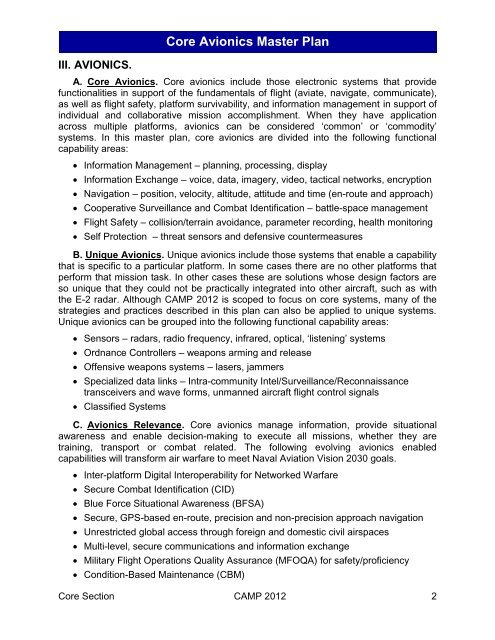PMA209 2012 Core Avionics Master Plan - NAVAIR - U.S. Navy
PMA209 2012 Core Avionics Master Plan - NAVAIR - U.S. Navy
PMA209 2012 Core Avionics Master Plan - NAVAIR - U.S. Navy
You also want an ePaper? Increase the reach of your titles
YUMPU automatically turns print PDFs into web optimized ePapers that Google loves.
<strong>Core</strong> <strong>Avionics</strong> <strong>Master</strong> <strong>Plan</strong>III. AVIONICS.A. <strong>Core</strong> <strong>Avionics</strong>. <strong>Core</strong> avionics include those electronic systems that providefunctionalities in support of the fundamentals of flight (aviate, navigate, communicate),as well as flight safety, platform survivability, and information management in support ofindividual and collaborative mission accomplishment. When they have applicationacross multiple platforms, avionics can be considered ‘common’ or ‘commodity’systems. In this master plan, core avionics are divided into the following functionalcapability areas: Information Management – planning, processing, display Information Exchange – voice, data, imagery, video, tactical networks, encryption Navigation – position, velocity, altitude, attitude and time (en-route and approach) Cooperative Surveillance and Combat Identification – battle-space management Flight Safety – collision/terrain avoidance, parameter recording, health monitoring Self Protection – threat sensors and defensive countermeasuresB. Unique <strong>Avionics</strong>. Unique avionics include those systems that enable a capabilitythat is specific to a particular platform. In some cases there are no other platforms thatperform that mission task. In other cases these are solutions whose design factors areso unique that they could not be practically integrated into other aircraft, such as withthe E-2 radar. Although CAMP <strong>2012</strong> is scoped to focus on core systems, many of thestrategies and practices described in this plan can also be applied to unique systems.Unique avionics can be grouped into the following functional capability areas: Sensors – radars, radio frequency, infrared, optical, ‘listening’ systems Ordnance Controllers – weapons arming and release Offensive weapons systems – lasers, jammers Specialized data links – Intra-community Intel/Surveillance/Reconnaissancetransceivers and wave forms, unmanned aircraft flight control signals Classified SystemsC. <strong>Avionics</strong> Relevance. <strong>Core</strong> avionics manage information, provide situationalawareness and enable decision-making to execute all missions, whether they aretraining, transport or combat related. The following evolving avionics enabledcapabilities will transform air warfare to meet Naval Aviation Vision 2030 goals. Inter-platform Digital Interoperability for Networked Warfare Secure Combat Identification (CID) Blue Force Situational Awareness (BFSA) Secure, GPS-based en-route, precision and non-precision approach navigation Unrestricted global access through foreign and domestic civil airspaces Multi-level, secure communications and information exchange Military Flight Operations Quality Assurance (MFOQA) for safety/proficiency Condition-Based Maintenance (CBM)<strong>Core</strong> Section CAMP <strong>2012</strong> 2

















